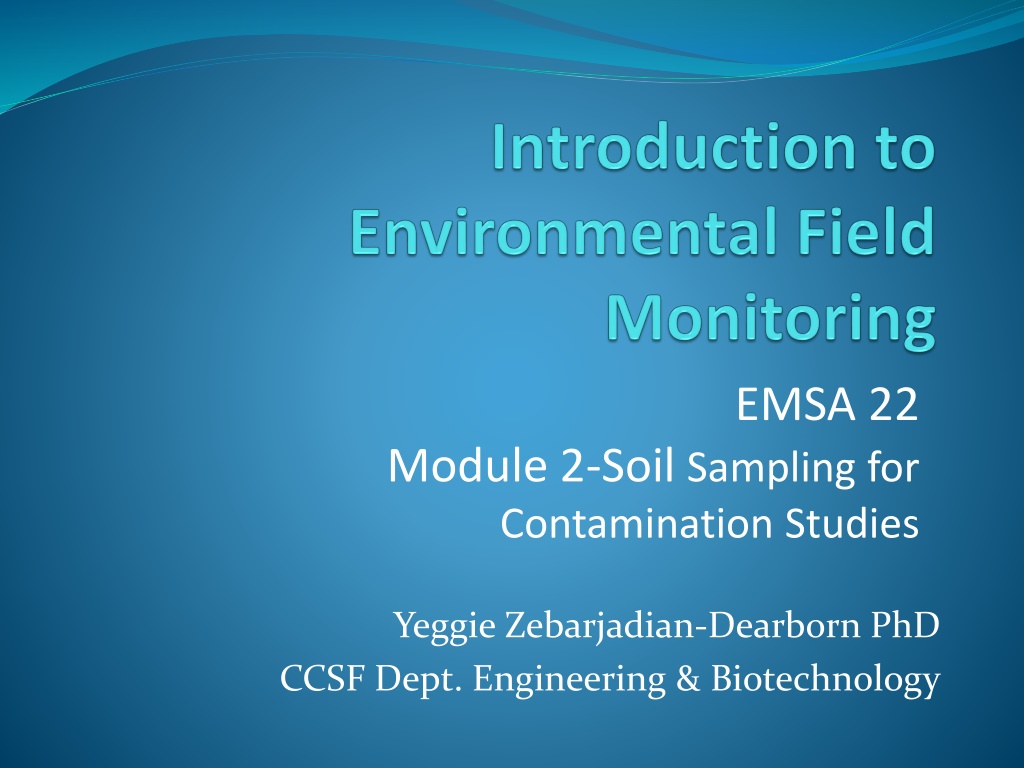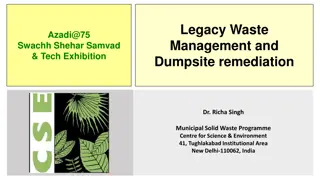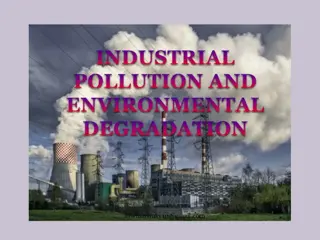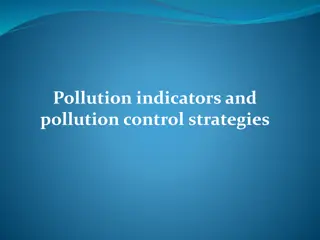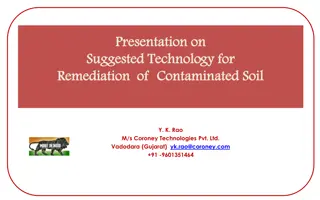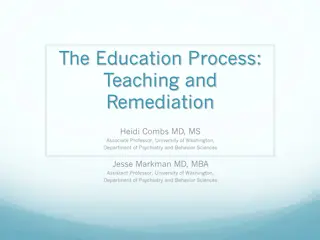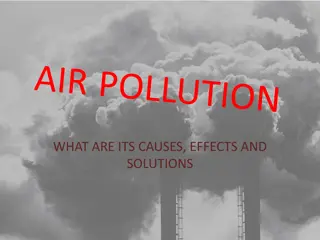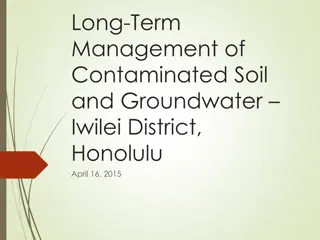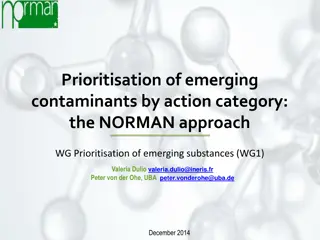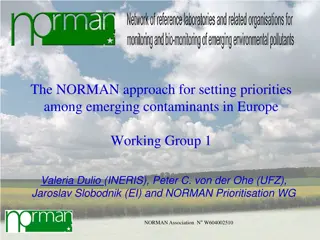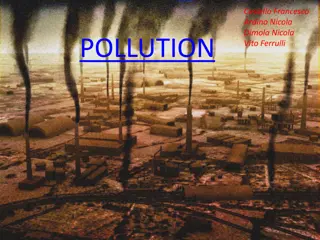Understanding Soil Pollution and Contaminants: Impact, Regulations, and Remediation
Effects of Soil Pollution include harm to aquatic life, crop contamination, structural damage, and health risks. Various contaminants of concern, such as heavy metals and radioactive compounds, pose threats to the environment and human health. Regulations by the EPA and California EPA set screening levels for soil pollutants to mitigate risks. Proper soil sampling and analysis methods are crucial for contamination studies, ensuring safe re-use or disposal of contaminated soil.
Download Presentation

Please find below an Image/Link to download the presentation.
The content on the website is provided AS IS for your information and personal use only. It may not be sold, licensed, or shared on other websites without obtaining consent from the author. Download presentation by click this link. If you encounter any issues during the download, it is possible that the publisher has removed the file from their server.
E N D
Presentation Transcript
EMSA 22 Module 2-Soil Sampling for Contamination Studies Yeggie Zebarjadian-Dearborn PhD CCSF Dept. Engineering & Biotechnology
Objective What are Effect of Soil Pollution? Identify Regulations concerned with Soil Contaminations-Soil Hazard Objective of Soil Sampling-Soil Re-use or disposal? Field Sampling Rationale and Design Field Methods and Procedures Field Safety Analytical Methods Sample Preservation, containers, Storage, and Transport under chain of custody documentation
Effects of Soil Pollution Pollution runs off into rivers and kills the fish, plants and other aquatic life Crops grown on polluted soil may pass the pollutants on to the consumers Soil structure is damaged (clay ionic structure impaired) Corrosion of foundations and pipelines Impairs soil stability May release vapors and hydrocarbon into buildings and cellars May create toxic dusts May poison children playing in the area (human health effects, carcinogens, developmental toxins..)
Contaminants of concern The number of different chemicals and the total amount of chemicals produced will increase in the future. U.S. releases toxicants such as detergents, fertilizers, propellants, pesticides, refrigerants, and many other chemicals. These often accumulate in the environment. Feces and urine contain biological nitrogen waste and are produced by animals. Radioactive compounds yield other radioactive metabolites, which can be as hazardous or more so than the parent compound. Heavy metals are utilized in many industrial processes and products. These often alter biological activity in organisms.
Regulation Pertaining to Soil Contaminants EPA Water Quality Resource Control Board, has established screening levels (Environmental Screening Levels or ESL ) for a number of soil pollutants where contaminated soil is a concern: Residential land use Commercial /Industrial land use Ecological impact to groundwater The California EPA Office of Environmental Health Hazard Assessment (OEHHA) published California Human Health Screening Levels to ensure minimize human health impact Source: http://www.swrcb.ca.gov/rwqcb2/water_issues/available_docu ments/ESL_May_2008.pdfCHHSLs)
Hazardous Waste Regulation-Soil Resource Conservation and Recovery Act (RCRA) Modern hazardous waste regulations in the U.S. began with the Resource Conservation and Recovery Act (RCRA) which was enacted in 1976. The primary contribution of RCRA was to create a "cradle to grave" system of record keeping for hazardous wastes. Hazardous wastes must be tracked from the time they are generated until their final disposition. RCRA's record keeping system helps to track the life cycle of hazardous waste and reduces the amount of hazardous waste illegally disposed.
Hazardous Waste Regulation-Soil Comprehensive Environmental Response, Compensation, and Liability Act (CERCLA)- EPA Enacted in 1980. The primary contribution of CERCLA was to create a "Superfund" and provided for the clean-up and remediation of closed and abandoned hazardous waste sites. Superfund created the Agency for Toxic Substances and Disease Registry (ATSDR), and it provides broad federal authority to clean up releases or threatened releases of hazardous substances that may endanger public health or the environment.
Hazardous Waste Regulation-Soil Before, hazardous wastes were being disposed in regular landfills until scientists measured unfavorable amounts of hazardous materials seeping into the ground. These chemicals eventually made their way to the water systems, and contaminated the soil that animals and crops used, as well as the soil that people employed to build their communities. After these regulations were put into practice, many landfills require now countermeasures against groundwater contamination; for example installing a barrier along the foundation of the landfill to contain the hazardous substances that may remain in the disposed waste.
California Regulations California Administrative Manual (CAM) add even more stringent regulations for control of hazadous waste -Example: Heavy Metals-also referred to as CAM17 metals refer to 17 heavy metals for which hazardous concentrations have been established. California Proposition 65 regulates substances as causing cancer or birth defects or other reproductive harm in two ways. -Prohibits businesses from knowingly discharging listed substances into drinking water sources, or onto land where the substances can pass into drinking water sources. -The second regulatory arm of Proposition 65 prohibits businesses from knowingly exposing individuals to listed substances without providing a clear and reasonable warning. Examples: lead or asbestos warning signs in construction sites, where soil is known to contain these pollutions in potentially hazardous concentrations
Sampling Objectives Just like water quality sampling a sampling and analysis objective must be in place to answer the following questions: What is the purpose of the sampling? Soil reuse or disposal What parameters need to be sampled for? What type of Field sampling should be designed? How many samples to collect? Site Background: Is there evidence of historical contamination or hazardous material on the site? e.g underground fuel tanks? Is there any information on spills ? Is presence of hazardous conc. of metals suspected from past industrial use of the sites? These questions can be addressed in a Sampling and Analysis Plan (SAP)
Sampling Design There are several sampling approaches that may be implemented at a site. The intent behind the selection of one sampling approach over another is to ensure that the sample reflects the characteristics of the population or media being sampled- So the following need to be established in the SAP: Sampling Schemes Sampling Locations Sampling Methods and Equipment Decontamination Procedures during sampling Analytical Methods Containers, Holding Times, & Preservation 1. 2. 3. 4. 5. 6.
Sampling Schemes 1. Authoritative / Biased / Judgmental The selection of locations is based on knowledge of contaminant distribution and properties (such as homogeneity). Used for screening purposes to see extent of contamination at a site. (example spill) 2. Random Sampling/Unbiased The selection of locations is random to achieve mathematical and statistically relevant results. Random sampling is typically applied to waste sites with unknown or variable concentrations of pollutants)
Types of Samples Composite sampling Consists of taking multiple Grab samples over a temporal or spatial range, physically combining equal portions and drawing one or more subsamples for analysis. Composite samples are taken primarily when an average concentration is sought Composite samples are most valuable in large study areas with sampling grids that cover areas from 100 to 500 feet per side. Grab Samples- Collected for specific location, hot spots (highest level of contaminant is suspected) or individual samples to prepare a composite sample.
Sample Location Large areas example 200 x 400 square feet area: The sample locations may be determined through the development of a sample unit grid for the site. GPS of Global Positioning System is used in the field to pinpoint the sampling area Grid sampling, can be random, systematic or based on depth; Top 3 ft 6 ft below Ground surface Random within a grid Systematic within grid nodes
Sample Location Soil Stockpile- Excavated material Depends on the size of the soil stockpile. Small stock pile can be divided into 4 sections and a grab sample collected from each section. Large stockpiles can be sampled from a number sections. Usually to save cost, 4 grabs will be collected from a small pile to be combined into a one-4point composite sample and provide a better representation of extent of contamination in the whole stockpile The bigger the soil pile the larger the number of 4-point composites
Sampling Equipments Earthmoving equipment, Drills, augurs or hand equipment as appropriate to excavate the area of investigation. Then use stainless steel equipment (spade, trowel etc) to obtain a clean sample. Place sample in Brass tubes or wide mouth clean glass jars Make sure to place a label on each sample http://www.plantmanagementnetwork.org/pub/cm/research/soilprobe/image/sampling1s.jpg
Equipment Decontamination Wash all equipment between sampling locations. Dry on clean paper towels. Earthmoving equipment only needs the loose dirt removing from it as smaller sampling holes are made in the exposed soil surface by the smaller stainless steel equipment. To avoid Cross-contamination Wash equipment using three buckets: 1) One with phosphate-free laboratory detergent, Alconox detergent 2) one with tap water and one with distilled water. 3) Use plastic scrubbing brushes in the first two buckets. 4) The brushes MUST STAY IN THEIR RESPECTIVE BUCKETS so as not to transfer contaminants.
Field Safety-General When sampling soil from areas containing known or suspected hazardous substances, adequate precautions must be taken to ensure the sampler s safety Safety boots are mandatory Other Personal Protective Gears: This may include Hard hat, disposable overalls, gloves, overshoes and respirators Site accessibility-Not climbing into trenches! Safety should be spelled out in Sampling Plan
SAMPLE PRESERVATION, CONTAINERS, HANDLING, AND STORAGE Chemical preservation of solids is generally not recommended. Cooling is usually the best approach, supplemented by the appropriate holding time. Wide-mouth glass containers with Teflon-lined caps are utilized for soil samples. The sample volume is a function of the analytical requirements and will be specified in the work plan. Transfer soil from the sample collection device to an appropriate sample container using a stainless steel or plastic scoop or equivalent. If composite samples are collected, place the soil sample in a stainless steel, plastic or other appropriate composition (e.g.: Teflon) bucket, and mix thoroughly to obtain a homogeneous sample representative of the entire sampling interval. Then aliquot the soil sample into labeled containers. Samples for volatile organic analysis must be collected directly from the bucket, before mixing the sample, to minimize loss due to volatilization of contaminants.
Quality Control/Quality Assurance Field observations must be documented on field data sheets -Examples include visual observation of soil: -homogenous or heterogeneous in content, Color, Odor etc.. must be recorded. Chain of custody document must accompany samples collected for lab analysis
Most Common Soil Contaminants for which laboratory methods are available VOCs: volatile organic compounds (eg. Benzene, toluene ethly benzene, xylene etc ) SVOC: semivolatile organic compound (phenols) PAH: polyaromatic hydrocarbon (Fossil fuel bi-products) PCB: polychlorinated biphenyl (plasticizers in paints and cements casting agents ,fire retardant fabric treatments and heat stabilizing additives for PVC electrical insulation ,adhesives paints and water-proofing TPH-petroleum hydrocarbon in forms of gas, diesel motor oil Heavy Metals (lead, mercury, cadmium, chromium et ) Pesticides, Herbicides
Analytical Methods EPA Methods California Methods Other Methods -Research -Laboratory developed -ASTM (American Society for Testing and Materials)
Analytical Methods EPA methods applicable to Soil SW-846 manual hazardous waste Sources of EPA Methods (http://www.epa.goCalifornia Methods CAM 17: California Administrative Manual (CAM) analytical method for 17 Metals
Analytical method-Hazardous Waste Characteristic TCLP: Toxicity Characteristic Leaching Procedure Required by Federal EPA STLC (Soluble Threshold Limit Concentration) using Waste Extraction Techniques (WET) Required by State California TTLC Total Threshold Limit Concentration (California) TCLP and WET are extractions to simulate landfills leachate for samples with > 0.5% solids
10X TTLC Rule to Classify Soil as Hazardous If total analyte result is < TTLC limit, but > 10 times STLC limit, then WET required If WET results > STLC limit, then classify as hazardous waste Example for one of the CAM17 metals: lead (Pb) TTLC = 1,000 mg/kg STLC = 5 mg/kg TCLP = 5 mg/kg
Hazardous Soil Exercise-Scenario Prior to development of a 200 x 150 square feet of land into a residential complex, Sampling to depth of 5 ft below ground was recommended to determine if the surface soil has hazardous concentration of Heavy metals from past industrial metal finishing use. Analyte of concern included the one of the CAM 17 metals LEAD
Hazardous Soil Exercise-Hypothetical Scenario A grid system was developed to determine hot spots (or areas most contaminated). Three 4-point composite samples were generated from 12 grids (A through L ) sampled to depth of 5 ft below ground surface . A sample ID was given to each composite sample: -Comp-1 -5 (Grid A, B, C,D) -Comp-2-5 (Grid E, F, G,H) -Comp-3-5 (Grid I, J, K,L) Grab samples from grids were mixed and 4-point composite Samples were collected in 8 oz Jars, tighly sealed and placed in a cooler and submitted under chain of custody documentation to a State Certified Lab for analysis of TTLC/STLC lead; No preservative was required for Lead analysis Holding time for sample <180 days.
Hazardous Soil Exercise-Lab results: -Comp-1 -5 (Grid A, B, C,D) TTLC for Lead=1100 mg/L STLC for Lead= 6.5 mg/L -Comp-2-5 (Grid E, F, G,H) TTLC for Lead=45 mg/L STLC for Lead= 4.3 mg/L -Comp-3-5 (Grid I, J, K,L) TTLC for Lead=52 mg/L Conduct Wet STLC for Lead= 5.5 mg/L
Hazardous Soil Exercise Is the Soil at this Site Hazardous? Working in groups of 2 or 3, you have 15-20 minutes . Using the 10x TTLC rule review the Lab results & determine whether soil from any grid areas sampled contains hazardous or non-hazardous concentration of lead.
Hazardous Soil Determination Answer Comp-1-5 (Grid A, B, C,D) TTLC for Lead=1100 mg/L >10X TTLC for Lead STLC for Lead= 6.5 mg/L Hazardous -Comp-2-5 (Grid E, F, G,H) TTLC for Lead=45 mg/L < 10X TTLC for Lead STLC for Lead= 4.3 mg/L Non-Hazardous -Comp-3-5 (Grid I, J, K,L) TTLC for Lead=52 mg/L >10X TTLC for Lead STLC for Lead= 5.5 mg/L Hazardous
Soil disposal/reuse Hazardous area can be segregated from Non- Hazardous area and soil off-hauled to a landfill that accepts the hazardous material Non-Hazardous soil will be screened against levels established under Environmental screening level sfor re-use suitability If not suitable for re-use, contaminated (non- hazardous will be off-hauled to a separate facility Cost for hazardous disposal is more expensive than non-hazardous soil!!!
Alternative to disposal-Soil Bioremediation/Biodegradation Encourages growth and reproduction of microorganisms (bacteria and fungi) to enhance biodegradation of organic constituents in the soil Three categories of bioremediation techniques have been identified. 1) In- situ land treatment-treatment of contaminated material in place--is a method for bioremediation of contaminated soil and, to some extent, of associated groundwater. 2) Biofiltration methods. Biofilters will either collect the pollutants or biodegrade contaminants to harmless materials. 3) Bioreactors are the third and most technologically sophisticated category of environmental bioremediation. Bioreactors offer a much faster means of waste biodegradation than land treatment and more control over reaction conditions and effluent quality than simple biofilters.
